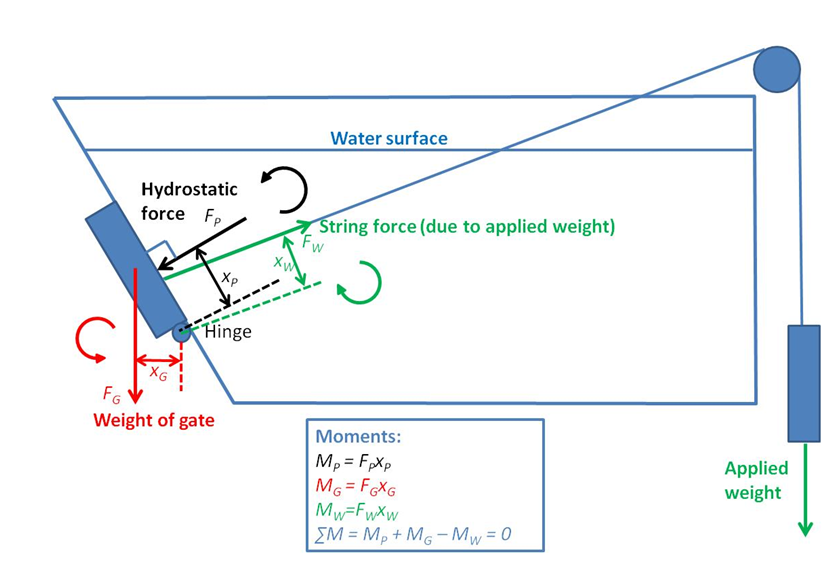Calculations
By measuring the water depth at the critical point (i.e. when the gate opened) you can assume that at this point in time, the moment generated by the hydrostatic force was in balance with the other moments acting on the gate. Shortly after that, the water level changed, creating an imbalance in moments that ultimately forced the gate to swing open.
You are required to combine your mechanics knowledge and your understanding of hydrostatic forces in order to predict the water depth that would generate the critical “balanced moment” state, and compare this with the observed water depth at the critical point.
The example in the image above shows how you go about calculating the moments in this experiment – however, each gate system is slightly different so you will need to build up the picture of forces and moments according to the particular gate you have chosen to analyse.
The gate experiences three main forces: the force due to its own weight (FG), the force due to the applied weight through the string (FW) and the hydrostatic force (FP). Each of these forces generates a moment about the hinge, proportional to the perpendicular distance from the line of action of the force to the centre of the hinge. You will need to determine two of these distances (XW ang XG) by measuring directly off the scale drawing provided.
At the critical point, the moments are balanced. In the example shown above, MP and MG operate in the same direction (counter-clockwise), opposing the moment MW generated by the string force. By setting the sum of the moments equal to zero, you can solve for MP as you have been given the necessary information to calculate MG and MW.
Once you know the moment MP, you need to use this to determine the water depth. This means you must develop an expression for the force FP as a function of water depth, starting with the general formula for hydrostatic force:

Next, you need to develop an expression for xP as a function of water depth, starting with the general formula for the location of hydrostatic force:

Once you have determined expressions for FP and xP as a function of water depth, you can multiply the two terms together to determine MP as a function of water depth. Because you have been able to calculate MP by balancing moments (as per above) this will allow you to predict the water depth at the critical point.
As with other experiments, you should report on the relative (%) difference between observed and predicted values and discuss possible reasons for any discrepancy.
TASK 1:
Determine, for the water level at balance in each case, the hydrostatic force (F) operating, the location of the centre of pressure (LP) on the gate and the direction of the line of action of the force F (acting through LP).
TASK 2:
Evaluate the moment of the force F about the axis of the hinge. This must equal the moment of the string force W about the axis of the hinge plus or minus (depending on which gate you are calculating) the moment of the gate weight force about the hinge. At the critical depth the moments should be balanced; therefore you can calculate the required magnitude of the string force.
TASK 3:
Compare your computed values for W1, W2 or W3 (depending on the gate and weight you are using) with their actual values - 12.9N, 10. 2N, 13.0N respectively - and suggest possible causes for any discrepancies observed.
